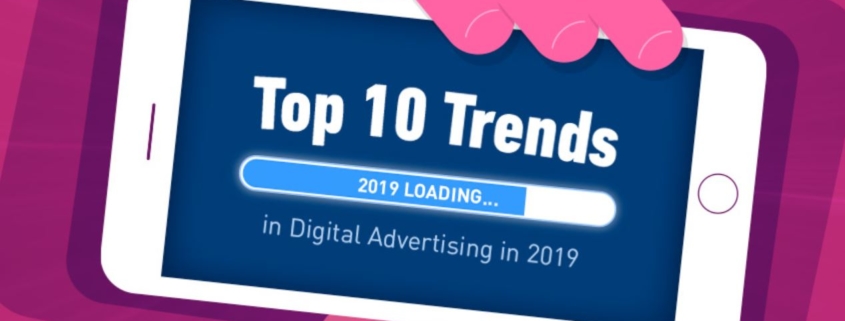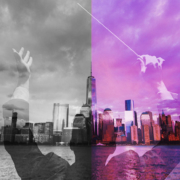Top 10 Trends in Digital Advertising in 2019
As we jump headlong into 2019, the digital advertising industry continues its exciting journey through new ad formats, breaking news, and shifting ad budgets. To dive deep into the state of the industry and anticipate what the New Year will bring, we dove into industry data and the Marin Advertising Index—which represents billions of dollars of annual ad spend on the Marin platform. These 10 trends in digital advertising indicate new possibilities, persistent challenges, and ongoing turf wars among major industry players.
1. Blurred Lines: Google, Facebook, and Amazon
As the triopoly rises to the top and competes fiercely with each other for digital ad dollars, the worlds of search, social, and eCommerce will continue to blend together. Amazon is essentially a massive search engine now, Google has seen great success with Shopping Ads, and now Facebook, through Instagram, is becoming a major player in eCommerce. How can marketers optimize spend?
The Opportunity: Marketers will need to work hard to connect the dots across all these different channels and seek out an independent view of the entire customer journey, especially as lines are blurring across publishers and devices.
2. The Rise of Instagram and Facebook Stories
During its Q3 2018 earnings call, Facebook reported that more than one billion Stories are shared daily across Facebook, Instagram, and WhatsApp. And where consumers go, marketers follow. Marin Software’s Q3 Digital Advertising Benchmark Report found Stories represented 25% of their total Instagram ad spend, up from just 8% a year earlier—that’s a 212% increase YoY and rising.
The Opportunity: Because Stories are such a rich, immersive ad format, there’s plenty of opportunity to experiment with engaging creative. But brands are at the mercy of users’ thumbs clicking through the story quickly, since Facebook hasn’t yet implemented unskippable ads like Snapchat. So, it’s more important than ever to get the creative right, especially since Facebook is still working out the kinks of the format.
3. The Chatbot and Messenger Brand Advantage
The number of mobile messaging app users in the U.S. will reach 171.3 million by 2022, according to eMarketer estimates. Advertisers are only just beginning to realize the true potential of the channel.
The Opportunity: Messenger apps present an opportunity for brands to move conversations forward in a way unlike any other format. Brands can have asynchronous conversations—where they can pop in and out of the app—at various points along the customer journey (when a user abandons the shopping cart, for example).
4. Brace for Impact: CCPA Is Just the Beginning
Brands should be prepared for more states, and possibly the federal government, to follow in California’s footsteps with GDPR-like regulations. As industry leaders and government officials continue to take strides toward privacy requirements, marketers need to understand their data infrastructure and make preparations now, anticipating that new regulations will go into effect and shake up ad strategies.
The Opportunity: While these changes may seem daunting now, it’s important to remember that it’s still possible to reach consumers in a courteous way, respecting those who choose to not have their data shared and honoring those who do share their data but still want it protected. This mutual understanding and promise of transparency will keep companies in a good light, and shouldn’t deter them from continuing to create meaningful, engaging, and relevant advertising and marketing experiences for customers and prospects.
5. Data, Data, Everywhere
Google’s search query report tells you exactly what people have searched for. That’s a fire hose for any company to see what their customers are really seeking. Users often search for something much broader than a specific product, and beyond shaping marketing strategy, such marketing-centric data will increasingly be utilized across the organization.
The Opportunity: The smartest marketers will keep mining search and other types of data to stay competitive, whether it’s to improve the customer experience or inform product, services, and merchandising decisions. For example, marketers can use search intent to uncover valuable insights across channels, and take advantage of specific terms and user behaviors to fuel ongoing brand strategies and tactics.
6. The Digital Is Political: New Rules for 2020
The 2018 midterm elections changed the rules for political ads. Between shrinking TV ad influence, growing digital ad spend, and general public distrust in social media, candidates had to get creative and fork out some major cash in order to come out on top.
Much of this spend was directed towards social ads, with some estimates showing “60 percent of every digital ad dollar goes toward social networks, including Facebook, Twitter, YouTube, Snapchat and Instagram.” This was only a glimpse into the political ad frenzy that we’ll begin to experience in 2019 as the next presidential election approaches.
The Opportunity: Political advertisers are entering a new landscape—one that’s harder to break through with all the digital noise and distrust. Candidates must be diligent about utilizing data and understanding which channels are generating the most impact, and maximizing spend accordingly.
7. eCommerce Joins the Advertising Party
2018 was the year of Amazon, as it turned the duopoly into a triopoly and officially became the third largest digital advertising platform in the U.S. behind Facebook and Google. But Amazon isn’t the only retailer seeing major success in eCommerce—other major players are bound to follow suit by monetizing their websites.
The Opportunity: As eCommerce rises as an advertising channel, expect to see other giants like eBay and Walmart mimicking Amazon’s success to turn their own websites into advertising channels. After all, Amazon leads U.S. companies in nearly half of total retail eCommerce sales, but eBay and Walmart are not far behind at no. 2 and no. 3.
Looking beyond the U.S., it’s interesting to note that Alibaba, Baidu, and Tencent all take a significant share of the Chinese ad market, according to eMarketer’s Global Ad Spend Update.
8. Next-Gen Search: Visual and Voice
Google, Facebook, and Amazon are all players in the voice search game. According to Chatmeter, more than 50% of consumers own a smart speaker and use it daily. Amazon reports fielding an average of 130 million questions a day via “Alexa.” The opportunity for this next-generation version of search is huge—and visual search is on the horizon, taking search to an entirely new level.
For example, Snapchat recently announced a partnership with Amazon to offer users a new image-based shopping feature—users snap a photo of a product and Amazon will ring up a menu of store purchase options.
The Opportunity: Both voice and visual search are poised to be game-changers for marketers, and the opportunities for brands are still in the early days. One thing is for certain: voice and visual cannot be approached in the same way as traditional search. In fact, if Google and Amazon focus on capturing value from the transaction, Alexa and Google Home could be surprisingly free of traditional “ads.” The value is in the query and brands will need to figure out how to rise to the top.
9. AI’s All Over Search, but Creative’s Not Dead
A/B testing is dead, thanks to the introduction of technology like responsive search ads that put Google’s machine learning capabilities into the hands of advertisers. But with less time testing and more time to come up with smart and innovative campaigns, it’s certainly a time for marketers to ramp up the creative ingenuity.
The Opportunity: The rise of ML/AI in advertising will open up new doors for marketers to focus on their customer, deliver relevant and engaging ads, and spend more time thinking about what goals really matter. Spending less time in the trenches testing multiple creative will allow advertisers to focus on the real deliverables of any marketing initiatives.
10. Influencers Go Cross-Channel
A study conducted earlier this year found that 62 percent of marketers were planning to grow their influencer marketing budgets in 2018. Meanwhile, 61 percent of influencers said they had more sponsored partnership opportunities in 2017 than they had in 2016, and that number will surely rise in years to come as Instagram and other platforms gain popularity.
The Opportunity: Expect to see influencer marketing being incorporated into broader cross-channel campaigns and strategies. As influencers become an increasingly important part of the customer journey and continue to “influence” purchase decisions, the industry must work toward better attribution models for this fairly new form of engagement.











